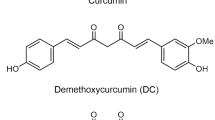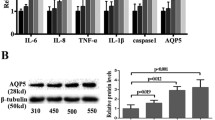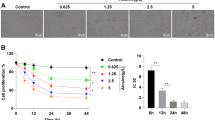Abstract
Background
To analyze the effects of supplemental epidermal growth factor (EGF) and the roles of inflammatory cytokines (interleukin [IL]-6) in an ex vivo dry-eye model under hyperosmotic stress using a multilayered culture of human conjunctival epithelial cells (HCECs).
Methods
Multilayered cultures of HCECs were exposed to hyperosmotic stress (400 mOsm/L) for 24 h in addition to 0.5 ng/mL EGF (low-EGF group) or 25 ng/mL EGF (high-EGF group). Apoptosis was analyzed using the TUNEL assay. Cell proliferation was measured using the [3H]-thymidine incorporation assay. The expression of IL-6, EGF, EGF receptor (EGFR), and phosphorylated extracellular signal-regulated kinase (p-ERK) was measured by western blot analysis. The secretion of IL-6 was measured using ELISA. Western blot analysis was also performed using antibodies against cleaved caspase-3.
Results
The percentage of apoptotic cells was lower in the high-EGF group (6.7 %) than in the low-EGF group (10.3 %). The high-EGF group demonstrated increased proliferation (323.7 counts/min in the low-EGF group vs 649.1 counts/min in the high-EGF group). EGF induced higher phosphor-EGFR expression and upregulated p-ERK in HCECs. In addition, EGF significantly decreased the secretion of IL-6 and cleaved caspase-3 in HCECs.
Conclusions
The level of IL-6 was increased in the ex vivo HCEC dry-eye model that was under hyperosmotic stress. Supplemental EGF reduces the level of IL-6, decreases apoptosis, and increases proliferation. These findings indicate that EGF has potential as a therapeutic agent for the treatment of dry eyes.




Similar content being viewed by others
References
Brewitt H, Sistani F (2001) Dry eye disease: the scale of the problem. Surv Ophthalmol 45(Suppl 2):S199–202
Foulks GN (2008) Pharmacological management of dry eye in the elderly patient. Drugs Aging 25:105–118
Behrens A, Doyle JJ, Stern L, Chuck RS, McDonnell PJ, Azar DT, Dua HS, Hom M, Karpecki PM, Laibson PR, Lemp MA, Meisler DM, Del Castillo JM, O’Brien TP, Pflugfelder SC, Rolando M, Schein OD, Seitz B, Tseng SC, van Setten G, Wilson SE, Yiu SC (2006) Dysfunctional tear syndrome: a Delphi approach to treatment recommendations. Cornea 25:900–907
WorkShop DE (2007) The definition and classification of dry eye disease: report of the Definition and Classification Subcommittee of the International Dry Eye WorkShop. Ocul Surf 5:75–92
Lemp MA (2008) Management of dry eye disease. Am J Manag Care 14:S88–101
Pflugfelder SC (2004) Antiinflammatory therapy for dry eye. Am J Ophthalmol 137:337–342
WorkShop DE (2007) Management and therapy of dry eye disease: report of the Management and Therapy Subcommittee of the International Dry Eye WorkShop. Ocul Surf 5:163–178
Latkany R (2008) Dry eyes: etiology and management. Curr Opin Ophthalmol 19:287–291
Narayanan S, Manning J, Proske R, McDermott AM (2006) Effect of hyperosmolality on beta-defensin gene expression by human corneal epithelial cells. Cornea 25:1063–1068
Bildin VN, Yang H, Crook RB, Fischbarg J, Reinach PS (2000) Adaptation by corneal epithelial cells to chronic hypertonic stress depends on upregulation of Na:K:2Cl cotransporter gene and protein expression and ion transport activity. J Membr Biol 177:41–50
Gilbard JP, Carter JB, Sang DN, Refojo MF, Hanninen LA, Kenyon KR (1984) Morphologic effect of hyperosmolarity on rabbit corneal epithelium. Ophthalmology 91:1205–1212
Li DQ, Chen Z, Song XJ, Luo L, Pflugfelder SC (2004) Stimulation of matrix metalloproteinases by hyperosmolarity via a JNK pathway in human corneal epithelial cells. Invest Ophthalmol Vis Sci 45:4302–4311
Li DQ, Luo L, Chen Z, Kim HS, Song XJ, Pflugfelder SC (2006) JNK and ERK MAP kinases mediate induction of IL-1beta, TNF-alpha and IL-8 following hyperosmolar stress in human limbal epithelial cells. Exp Eye Res 82:588–596
Pan Z, Wang Z, Yang H, Zhang F, Reinach PS (2011) TRPV1 activation is required for hypertonicity-stimulated inflammatory cytokine release in human corneal epithelial cells. Invest Ophthalmol Vis Sci 52:485–493
Enriquez-de-Salamanca A, Calder V, Gao J, Galatowicz G, García-Vázquez C, Fernández I, Stern ME, Diebold Y, Calonge M (2008) Cytokine responses by conjunctival epithelial cells: an in vitro model of ocular inflammation. Cytokine 44:160–167
Pflugfelder SC, Jones D, Ji Z, Afonso A, Monroy D (1999) Altered cytokine balance in the tear fluid and conjunctiva of patients with Sjogren’s syndrome keratoconjunctivitis sicca. Curr Eye Res 19:201–211
Shatos MA, Gu J, Hodges RR, Lashkari K, Dartt DA (2008) ERK/p44p42 mitogen-activated protein kinase mediates EGF-stimulated proliferation of conjunctival goblet cells in culture. Invest Ophthalmol Vis Sci 49:3351–3359
Shatos MA, Rios JD, Horikawa Y, Hodges RR, Chang EL, Bernardino CR, Rubin PA, Dartt DA (2003) Isolation and characterization of cultured human conjunctival goblet cells. Invest Ophthalmol Vis Sci 44:2477–2486
Chung SH, Lee JH, Yoon JH, Lee HK, Seo KY (2007) Multi-layered culture of primary human conjunctival epithelial cells producing MUC5AC. Exp Eye Res 85:226–233
Lee J, Jun EJ, Sunwoo JH, Kim ES, Kim JH, Kim JY, Kim MJ, Kim YK, Lee H, Tchah H (2011) An ex vivo model of coxsackievirus infection using multilayered human conjunctival epithelial cells. Graefes Arch Clin Exp Ophthalmol 249:1327–1332
van Setten GB, Tervo T, Viinikka L, Perheentupa J, Tarkkanen A (1991) Epidermal growth factor in human tear fluid: a minireview. Int Ophthalmol 15:359–362
Enriquez-de-Salamanca A, Castellanos E, Stern ME, Fernández I, Carreño E, García-Vázquez C, Herreras JM, Calonge M (2010) Tear cytokine and chemokine analysis and clinical correlations in evaporative-type dry eye disease. Mol Vis 16:862–873
Rao K, Farley WJ, Pflugfelder SC (2010) Association between high tear epidermal growth factor levels and corneal subepithelial fibrosis in dry eye conditions. Invest Ophthalmol Vis Sci 51:844–849
Luo L, Li DQ, Corrales RM, Pflugfelder SC (2005) Hyperosmolar saline is a proinflammatory stress on the mouse ocular surface. Eye Contact Lens 31:186–193
Corrales RM, Luo L, Chang EY, Pflugfelder SC (2008) Effects of osmoprotectants on hyperosmolar stress in cultured human corneal epithelial cells. Cornea 27:574–579
Li J, Zhu HY, Beuerman RW (2009) Stimulation of specific cytokines in human conjunctival epithelial cells by defensins HNP1, HBD2, and HBD3. Invest Ophthalmol Vis Sci 50:644–653
Adhikary G, Sun Y, Pearlman E (2008) C-Jun NH2 terminal kinase (JNK) is an essential mediator of Toll-like receptor 2-induced corneal inflammation. J Leukoc Biol 83:991–997
Yeh S, Song XJ, Farley W, Li DQ, Stern ME, Pflugfelder SC (2003) Apoptosis of ocular surface cells in experimentally induced dry eye. Invest Ophthalmol Vis Sci 44:124–129
Turner K, Pflugfelder SC, Ji Z, Feuer WJ, Stern M, Reis BL (2000) Interleukin-6 levels in the conjunctival epithelium of patients with dry eye disease treated with cyclosporine ophthalmic emulsion. Cornea 19:492–496
Luo L, Li DQ, Doshi A, Farley W, Corrales RM, Pflugfelder SC (2004) Experimental dry eye stimulates production of inflammatory cytokines and MMP-9 and activates MAPK signaling pathways on the ocular surface. Invest Ophthalmol Vis Sci 45:4293–4301
Massingale ML, Li X, Vallabhajosyula M, Chen D, Wei Y, Asbell PA (2009) Analysis of inflammatory cytokines in the tears of dry eye patients. Cornea 28:1023–1027
Singh AB, Harris RC (2005) Autocrine, paracrine and juxtacrine signaling by EGFR ligands. Cell Signal 17:1183–1193
Grant MB, Khaw PT, Schultz GS, Adams JL, Shimizu RW (1992) Effects of epidermal growth factor, fibroblast growth factor, and transforming growth factor-beta on corneal cell chemotaxis. Invest Ophthalmol Vis Sci 33:3292–3301
Fredj-Reygrobellet D, Plouet J, Delayre T, Baudouin C, Bourret F, Lapalus P (1987) Effects of aFGF and bFGF on wound healing in rabbit corneas. Curr Eye Res 6:1205–1209
van Setten GB, Schultz GS, Macauley S (1994) Growth factors in human tear fluid and in lacrimal glands. Adv Exp Med Biol 350:315–319
Barton K, Nava A, Monroy DC, Pflugfelder SC (1998) Cytokines and tear function in ocular surface disease. Adv Exp Med Biol 438:461–469
Nezu E, Ohashi Y, Kinoshita S, Manabe R (1992) Recombinant human epidermal growth factor and corneal neovascularization. Jpn J Ophthalmol 36:401–406
Lu L, Wang L, Shell B (2003) UV-induced signaling pathways associated with corneal epithelial cell apoptosis. Invest Ophthalmol Vis Sci 44:5102–5109
Krishnamoorthy M, Heimburg-Molinaro J, Bargo AM, Nash RJ (2009) Heparin binding epidermal growth factor-like growth factor and PD169316 prevent apoptosis in mouse embryonic stem cells. J Biochem 145:177–184
Li DQ, Tseng SC (1996) Differential regulation of cytokine and receptor transcript expression in human corneal and limbal fibroblasts by epidermal growth factor, transforming growth factor-alpha, platelet-derived growth factor B, and interleukin-1 beta. Invest Ophthalmol Vis Sci 37:2068–2080
Acknowledgments
This study was partially supported by a grant from the Korea Healthcare Technology R&D Project, Ministry of Health & Welfare, Republic of Korea (A101538) and partially by the National Research Foundation of Korea Grant funded by the Korean Government (2012R1A1A2003278).
Author information
Authors and Affiliations
Corresponding author
Rights and permissions
About this article
Cite this article
Kim, Jh., Kang, SS., Kim, E.S. et al. Osmoprotective effects of supplemental epidermal growth factor in an ex vivo multilayered human conjunctival model under hyperosmotic stress. Graefes Arch Clin Exp Ophthalmol 251, 1945–1953 (2013). https://doi.org/10.1007/s00417-013-2369-5
Received:
Revised:
Accepted:
Published:
Issue Date:
DOI: https://doi.org/10.1007/s00417-013-2369-5




